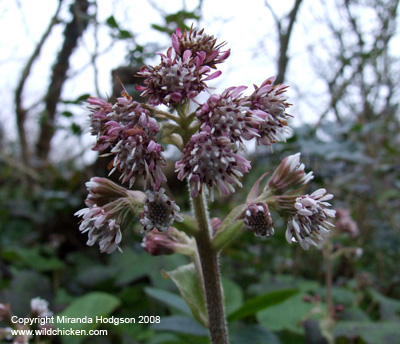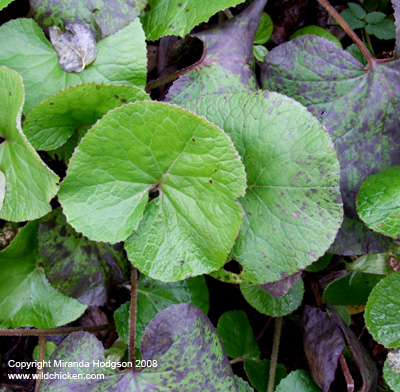


Petasites fragrans (also called Scented coltsfoot and Winter heliotrope)
Petasites
fragrans
Rampant, hardy, herbaceous, rhizomatous perennial grown for ground cover in wild gardens and for its fragrant flowers which are borne in winter. Like many winter flowering plants, the scent of Winter heliotrope is very strong (it is said to be similar to vanilla, though I thought it was more like marzipan). Winter plants are strongly scented so that the few insects about in winter will know that they are there and come and pollinate them.
Although good ground cover plant, it is unfortunately very invasive and only really suitable for large areas, or for those which are to be left to grow wild. It isn't a suitable plant for small gardens unless carefully contained. Originally from the Mediterranean, it is naturalised in the UK and can be found colonising hedge banks, stream and pond edges and waste ground.
This plant has reputedly been grown near beehives as it provides a very good source of nectar for early emerging bees and for other insects who wake during warm spells in winter and need something to eat.
At first glance it is similar to butterbur (Petasites hybridus), though this flowers in spring rather than winter.
Pale pink flowers in winter, green foliage in summer and autumn.
Habit - spreading, forming dense cover. Spreads by rhizomes. H: up to 30cm. S: as far as it can, up to 1m a year.
Stem - straight, rounded, hairy, green with tinges of pink.
Leaves - round, mid-green with serrated edges. The foliage is abundant in summer and blocks out pretty much all growth beneath it.
Flowers - clusters of small pink and white flowers are borne in winter, from November to February. The scent is strong and similar to vanilla or marzipan.
Sun to partial shade.
Does well in moist ground.
Hardy.
Unless you really want it, then maintenance is generally a matter of controlling its spread. It spreads easily by rhizomes and can grow up to 1m a year - the rhizomes must be very carefully dug out as any fragments will grow into new plants, so removing them can be laborious. An alternative is to spray with a systemic herbicide while the plant is growing strongly in mid-summer.
Spreads naturally by rhizome off-shoots and fragments.
Garden Plant Information list of plant care info by botanical name